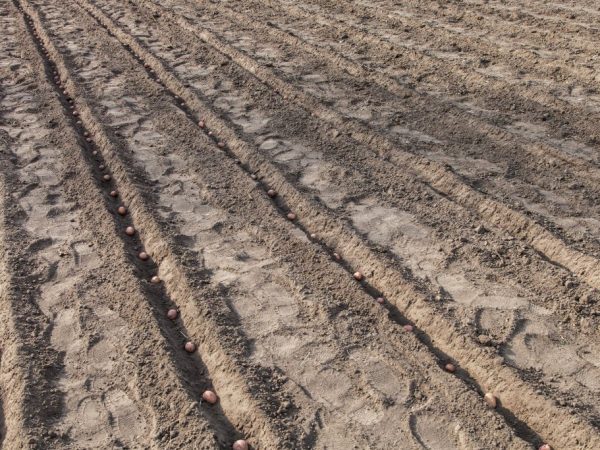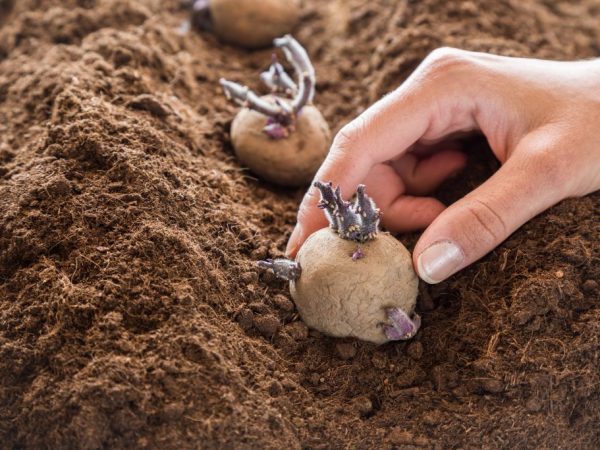Recommended soil temperature for planting potatoes
To get a high-quality and bountiful harvest, you need to know what soil temperature is required for planting potatoes in spring. Of course, in different regions of the country, the climate varies and it will not be possible to establish the exact date of planting. The timing of when potatoes withstand a cold snap or warming in spring directly depends on weather conditions, since only they affect the temperature of the soil. From year to year, the weather tends to change at the same time.

Recommended soil temperature for planting potatoes
In this case, the gardener needs to know when it is best to plant potatoes and how warm the soil should be. If you can cope with this task, then your plantings will not freeze and form large tubers. Different soils (black soil, loam, sandy) warm up each at its own pace. Also, the variety of potatoes you have chosen may require adherence to certain recommendations regarding the timing of planting.
Folk omens
Why is one of the old signs forbidding planting potatoes on Palm Sunday? If this was connected with the ancient Slavic rituals, it was also not accidental. This is actually a warning to those who are in too much of a hurry to board. Palm week can begin either in early April or even at the end of March. Of course, the weather in different regions is different, but still, by this time the earth has not yet had time to fully warm up.
The most literate of the predictions seem to be those that associate planting dates with changes in the state of other plants. For example, you cannot plant potatoes before the leaves bloom on the birch and later than the bird cherry blossoms. You can also stand on future potato ridges with bare feet and stand. If the legs do not get cold, they are comfortable on the ground, then it is quite possible that the potatoes will feel good in it.
Scientists' opinion
It is clear what the desire to put tubers in the ground is based on as early as possible - who does not want the potatoes to grow faster. And this does not contradict the scientific point of view at all. The fact is that the earlier the potato takes root and grows up, the more stable its natural immunity to various diseases, in particular viral, will be.
And early potato varieties have time to fully form the tubers and you can get a harvest even before late blight spreads through the gardens, which loves an air temperature of 20-25 ° C and rainy weather, which very often corresponds to the climate of many regions in Russia in the middle of summer.
Optimum soil temperature
What should be the minimum soil temperature in order to plant potatoes and get a bountiful harvest from them? Take a centimeter thermometer and measure the temperature of the soil. If the soil has warmed up to 7-8 ° degrees, then this is already good and such indicators are considered acceptable for growing. Be sure to take measurements at a depth of at least 10-12 cm. Pay attention to the air temperature - if it is stable at around 8-10 degrees, then the soil is most likely already suitable for growing your planting material.
Why should the soil temperature be exactly this? Because this is the optimum temperature for planting your potatoes. At this temperature, plant roots begin to actively penetrate into the soil. If the ground is colder than this line, and even saturated with moisture, the sown will most likely begin to rot, not having time to gain volume, and if it does not rot, it will grow.
Even a germinated crop will most likely not survive if you grow it in cold soil. A temperature from 1 to 5 is already a risk. The sprouts slowly and reluctantly, but will develop only starting from 3 degrees, but are you sure that a sharp cold snap will not come? Therefore, to be sure, wait for the stability of the daily weather.
Soil moisture

Soil moisture can be determined
You also need to pay attention to soil moisture. Planted tubers at 7-8 degrees, but in too wet soil, can easily become infected with ring rot and black leg (these are bacterial diseases) or rhizoctonia (black scab popularly). The critical level of soil moisture in the spring, which potatoes withstand, is 75%.
But how to determine if the soil is not too saturated with water, without special devices? In this case, it is recommended to trust the folk experience. Take a handful of earth, squeeze it into a lump and stretch out your hand, drop the lump on a hard place. If the lump has crumbled, then this means that the humidity does not exceed the critical level. If a sticky lump of dirt is lying in front of you, unfortunately you will have to wait with planting, planting potatoes in such soil is like throwing them into a swamp.
How to determine the type of soil?
- If you find a wet and wet clod of dirt in your area that does not crumble when thrown onto the soil, then the type of your garden soil is heavy. These are loam and clay soils.
- Medium soil is also loam, which differs into light and medium.
- Light soils are sandy.
Why is it important to know this? Because with this method of determination, you can find out what kind of soil in your garden and what the approximate temperature of the soil will be for planting potatoes. The lighter the soil, the faster it warms up, but also dries up. With light soil, do not pull with planting potatoes. If you miss the right moment, then the plantings will not have enough moisture for development.
There is also another method for determining the type of soil. To do this, the gardener needs to pick up a handful of damp earth. Next, you need to roll the soil into a lump and try to roll it out to get something like a sausage. If the sausage does not stick stubbornly, then you have a light soil. If it is easily blinded and bent into a ring, then the soil is moist and flexible. If it cracks immediately, then such a soil belongs to the average type. Well, if the viscous little piece of land is perfectly molded even into a sausage, at least into something else, then on your site there is solid clay, that is, heavy soil with high humidity. But with wet and clayey soils, problems with irrigation are not expected.
Preparing for landing
Potatoes prefer warmth in every sense of the word and cannot withstand the cold in spring. There is such a proverb among the people and it sounds like this: "When everyone was talking, the potatoes said: Plant me warm, dig me out warm and eat me warm too - that's all I want." It is worth reflecting on this statement and, if possible, provide warmth to your potatoes. You cannot plant seed that has just come from a damp cellar. Such tubers may not wake up for a long time.
If you have this type of potato, there are several ways to prepare raw and cold seed for planting.
- Vernalization is a pre-planting germination: 2-3 weeks in advance, put the tubers in a room where there is diffused light and store at a temperature of 12-15 degrees, the development of buds will naturally accelerate from light and heat.
- If you did not have time to carry out the germination procedure, it does not matter, arrange the withering of the potatoes (let them spend 8-10 days in a dry place at a temperature of 14-16 degrees).
Of course, the standard germination of seed material is more profitable in terms of time - such tubers sprout in 8-14 days, and the ripening of the crop occurs 1-2 weeks earlier. Potato bushes will rise higher, the tubers will develop immunity against bacteria and pathogenic fungi. Follow the schedule and timing of planting your potatoes, then you will have every chance of getting a bountiful and healthy harvest.


